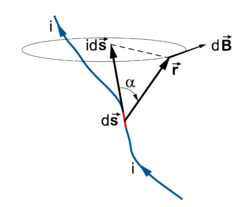Biot-Savart law: Difference between revisions
imported>Paul Wormer (New page: In physics, more particularly in electrodynamics, the law first formulated by Jean-Baptiste Biot and Félix Savart <ref>J.-B. Biot and F. Savart, ''Note sur le...) |
imported>Paul Wormer No edit summary |
||
| Line 1: | Line 1: | ||
In [[physics]], more particularly in [[electrodynamics]], the law first formulated by [[Jean-Baptiste Biot]] and [[Felix Savart|Félix Savart]] <ref>J.-B. Biot and F. Savart, ''Note sur le Magnétisme de la pile de Volta,'' Annales Chim. Phys. vol. '''15''', pp. 222-223 (1820)</ref> describes the magnetic field caused by a direct electric current in a wire. Biot and Savart interpreted their measurements by an integral relation. [[Laplace]] gave a differential form of their result, which now often is also referred to as the Biot-Savart law, or sometimes as the Biot-Savart-Laplace law. By integrating Laplace's equation over an infinitely long wire, the original integral form of Biot and Savart is obtained. | In [[physics]], more particularly in [[electrodynamics]], the law first formulated by [[Jean-Baptiste Biot]] and [[Felix Savart|Félix Savart]] <ref>J.-B. Biot and F. Savart, ''Note sur le Magnétisme de la pile de Volta,'' Annales Chim. Phys. vol. '''15''', pp. 222-223 (1820)</ref> describes the magnetic field caused by a direct electric current in a wire. Biot and Savart interpreted their measurements by an integral relation. [[Laplace]] gave a differential form of their result, which now often is also referred to as the Biot-Savart law, or sometimes as the Biot-Savart-Laplace law. By integrating Laplace's equation over an infinitely long wire, the original integral form of Biot and Savart is obtained. | ||
[[Image:Laplace magnetic.png|right|thumb|250px|Magnetic field d'''B''' at point '''r''' due to infinitesimal piece d'''s''' (red) of wire (blue) transporting electric current ''i''. ]] | |||
==Laplace's formula== | |||
The infinitesimal [[magnetic induction]] d'''B''' at point '''r''' is given by the following formula due to Laplace, | |||
:<math> | |||
d\vec{\mathbf{B}} = k \frac{i d\vec{\mathbf{s}} \times \vec{\mathbf{r}}} {|\vec{\mathbf{r}}|^3}, | |||
</math> | |||
where the magnetic induction is given as a [[vector product]], i.e., is perpendicular to the plane spanned by d'''s''' and '''r'''. The constant ''k'' depends on the units chosen. In rationalized SI units ''k'' is the [[magnetic constant]] (vacuum permeability) μ<sub>0</sub> = 4π ×10<sup>−7</sup> N/A<sup>2</sup> (newton divided by ampere squared). If we think of the fact that the vector '''r''' has dimension length, we see that this equation is an [[Inverse-square_law|inverse distance squared law]]. | |||
'''(To be continued)''' | '''(To be continued)''' | ||
==References== | ==References== | ||
<references /> | <references /> | ||
Revision as of 05:19, 6 February 2008
In physics, more particularly in electrodynamics, the law first formulated by Jean-Baptiste Biot and Félix Savart [1] describes the magnetic field caused by a direct electric current in a wire. Biot and Savart interpreted their measurements by an integral relation. Laplace gave a differential form of their result, which now often is also referred to as the Biot-Savart law, or sometimes as the Biot-Savart-Laplace law. By integrating Laplace's equation over an infinitely long wire, the original integral form of Biot and Savart is obtained.
Laplace's formula
The infinitesimal magnetic induction dB at point r is given by the following formula due to Laplace,
where the magnetic induction is given as a vector product, i.e., is perpendicular to the plane spanned by ds and r. The constant k depends on the units chosen. In rationalized SI units k is the magnetic constant (vacuum permeability) μ0 = 4π ×10−7 N/A2 (newton divided by ampere squared). If we think of the fact that the vector r has dimension length, we see that this equation is an inverse distance squared law.
(To be continued)
References
- ↑ J.-B. Biot and F. Savart, Note sur le Magnétisme de la pile de Volta, Annales Chim. Phys. vol. 15, pp. 222-223 (1820)

